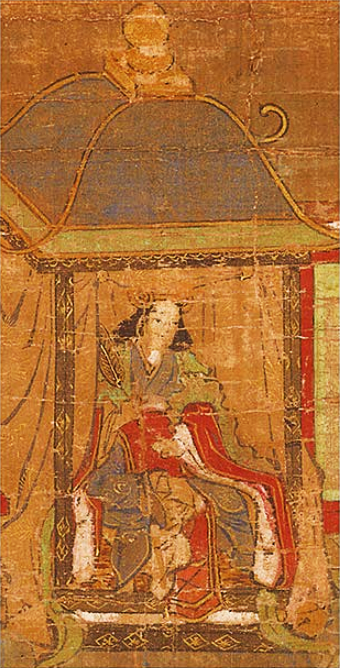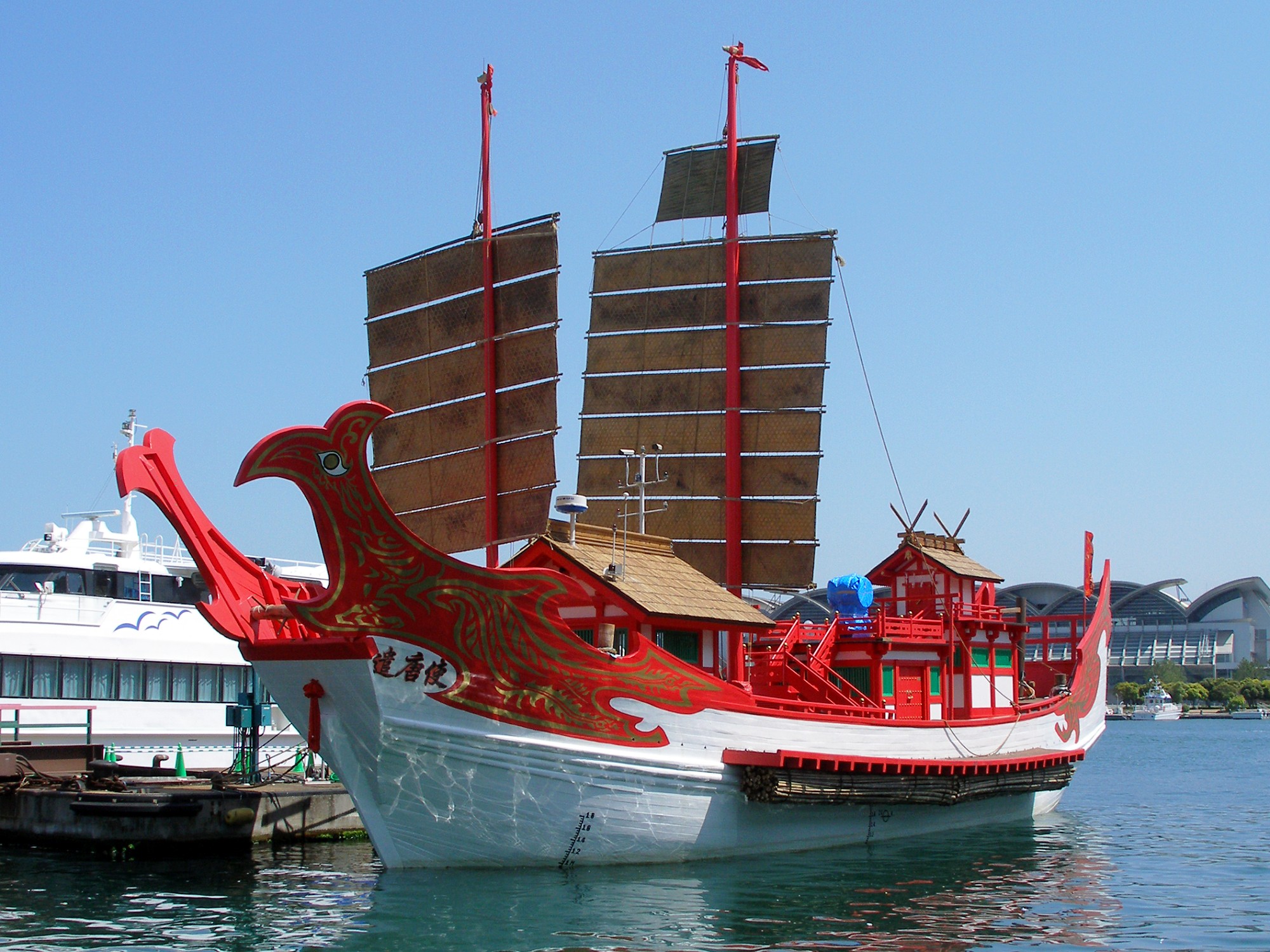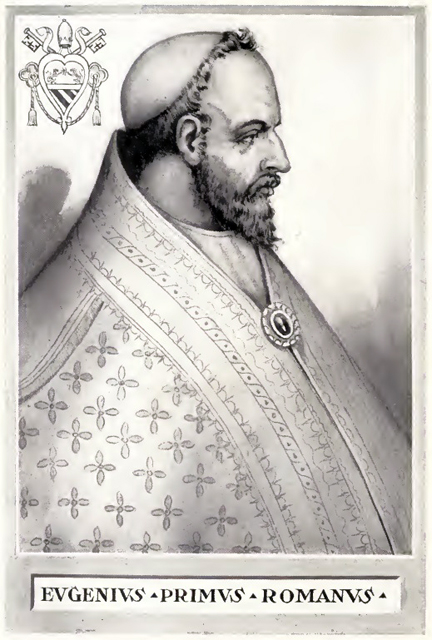|
Takamuko No Kuromaro
was a Japanese scholar and diplomat of the Asuka period. Karumauro traveled to China with Ono no Imoko as ''kenzuishi'' representing Empress Suiko in 608.Nussbaum, "Kentōshi" at He remained in China for thirty-two years.Nussbaum, "Takamuko no Kuromaro (No Genri)" at Following his return in 640, he was awarded the title ''Kuni no hakase'' (国博士, "National Scholar"). Karumauro helped write the Taika Reforms in 645. He was sent again as an ambassador to China ('' kentōshi''). Takamuko died upon his arrival in Chang'an in 654. See also * Notes References * Nussbaum, Louis Frédéric and Käthe Roth. (2005). ''Japan Encyclopedia''. Cambridge: Harvard University Press Harvard University Press (HUP) is an academic publishing house established on January 13, 1913, as a division of Harvard University. It is a member of the Association of University Presses. Its director since 2017 is George Andreou. The pres .... OCLC 48943301*Sansom, George (1961). ''A History of ... [...More Info...] [...Related Items...] OR: [Wikipedia] [Google] [Baidu] |
Asuka Period
The was a period in the history of Japan lasting from 538 to 710, although its beginning could be said to overlap with the preceding Kofun period. The Yamato period, Yamato polity evolved greatly during the Asuka period, which is named after the Asuka, Yamato, Asuka region, about south of the modern city of Nara, Nara, Nara. The Asuka period is characterized by its significant Japanese art, artistic, social, and political transformations, having their origins in the late Kofun period. The introduction of Buddhism marked a change in Japanese society. The Asuka period is also distinguished by the change in the name of the country from to . Naming The term "Asuka period" was first used to describe a period in the history of Japanese fine-arts and architecture. It was proposed by fine-arts scholars and Okakura Kakuzō around 1900. Sekino dated the Asuka period as ending with the Taika Reform of 646. Okakura, however, saw it as ending with the transfer of the capital to the Heijō ... [...More Info...] [...Related Items...] OR: [Wikipedia] [Google] [Baidu] |
Ono No Imoko
was a Japanese politician and diplomat in the late 6th and early 7th century, during the Asuka period. Ono was appointed by Empress Suiko as an official envoy ( Kenzuishi) to the Sui court in 607 (imperial embassies to China), and he delivered the famous letter from Japan's Prince Shōtoku which began "The Son of Heaven where the sun rises apan to the Son of Heaven where the sun sets hina may good health be with you." Emperor Yang was angered at being addressed in this way, although it is not clear whether he was angered more by the insult of Sui being referred to as the land of the setting sun, or by the use of Son of Heaven to refer both to himself and the emperor of Japan, hinting that they were equals. China at this time considered other realms to be nothing more than barbarians before the Huaxia ideology and any lands on the Earth's surface not engaged at the Sinocentric tributary system were called (; "lands outside of civilization"), the Emperor of China was consider ... [...More Info...] [...Related Items...] OR: [Wikipedia] [Google] [Baidu] |
Empress Suiko
(554 – 15 April 628) was the 33rd monarch of Japan,Imperial Household Agency (''Kunaichō''): She introduced Buddhism in Japan and built many Buddhist temples, but she held the balance between Buddhism and Shintoism. Under her rule, Japan was the superpower in Asia, Silla paid tribute to Japan. She also reorganized the legal system and laws, bringing a peaceful era in the country. She is credited with building Japan's infrastructure, economy and culture. Empress Suiko was noted for her wisdom as a ruler推古天皇 (33)/ref> and the country's first and longest-reigning empress regnant, according to the traditional order of succession. Suiko reigned from 593 until her death in 628. Traditional narrative Before her ascension to the Chrysanthemum Throne, her personal name (her ''imina'') was Mikekashiya-hime-no-mikoto, also Toyomike Kashikiya hime no Mikoto. Empress Suiko had several names including Princess Nukatabe and (possibly posthumously) Toyomike Kashikiya. She was a ... [...More Info...] [...Related Items...] OR: [Wikipedia] [Google] [Baidu] |
Taika Reforms
The were a set of doctrines established by Emperor Kōtoku (孝徳天皇 ''Kōtoku tennō'') in the year 645. They were written shortly after the death of Prince Shōtoku and the defeat of the Soga clan (蘇我氏 ''Soga no uji''), uniting Japan. The reforms also artistically marked the end of the Asuka period and the beginning of the Hakuhō period. Crown Prince Naka no Ōe (the future Emperor Tenji), Nakatomi no Kamatari, and Emperor Kōtoku jointly embarked on the details of the Reforms. Emperor Kōtoku then announced the era of " Taika" (大化), or "Great Reform". The Reform began with land reform, based on Confucian ideas and philosophies from Tang China, but the true aim of the reforms was to bring about greater centralization and to enhance the power of the imperial court, which was also based on the governmental structure of China. Envoys and students were dispatched to China to learn seemingly everything from the Chinese writing system, literature, religion, and arch ... [...More Info...] [...Related Items...] OR: [Wikipedia] [Google] [Baidu] |
Japanese Missions To Tang China
The were Japanese efforts to learn Chinese culture and civilization from Tang China, in the 7th, 8th and 9th centuries. The nature of those contacts evolved gradually from political and ceremonial change into cultural exchanges, and the process accompanied growing commercial ties which developed over time. From 607 to 839, Japan sent 19 missions to Sui and Tang Empires of China (a mission planned for 894 was cancelled). For each expedition, knowledge and learning were the principal objectives. Priests from Japan studied Chinese Buddhism, officials from Japan studied Chinese government, doctors from Japan studied Chinese medicine, and painters from Japan studied Chinese painting. Approximately one third of those who embarked from Japan did not survive to return home.Hoffman, Michael "Cultures Combined in the Mists of Time: Origins of the China-Japan relationship,"''Asia Pacific Journal: Japan Focus.'' February 3, 2006; reprinting article in ''Japan Times,'' January 29, 2006. S ... [...More Info...] [...Related Items...] OR: [Wikipedia] [Google] [Baidu] |
Chang'an
Chang'an (; zh, t=長安, s=长安, p=Cháng'ān, first=t) is the traditional name of the city now named Xi'an and was the capital of several Chinese dynasties, ranging from 202 BCE to 907 CE. The site has been inhabited since Neolithic times, during which the Yangshao culture was established in Banpo, in what is now the city's suburbs. Furthermore, in the northern vicinity of modern Xi'an, Qin Shi Huang of the Qin dynasty, China's first emperor, held his imperial court and constructed his massive mausoleum guarded by the Terracotta Army. From its capital at Xianyang, the Qin dynasty ruled a larger area than either of the preceding dynasties. The imperial city of Chang'an during the Han dynasty was located northwest of today's Xi'an. During the Tang dynasty, the area that came to be known as Chang'an included the area inside the Ming Xi'an fortification, plus some small areas to its east and west, and a substantial part of its southern suburbs. Thus, Tang Chang'an was eight t ... [...More Info...] [...Related Items...] OR: [Wikipedia] [Google] [Baidu] |
Harvard University Press
Harvard University Press (HUP) is an academic publishing house established on January 13, 1913, as a division of Harvard University. It is a member of the Association of University Presses. Its director since 2017 is George Andreou. The press maintains offices in Cambridge, Massachusetts, near Harvard Square, and in London, England. The press co-founded the distributor TriLiteral LLC with MIT Press and Yale University Press. TriLiteral was sold to LSC Communications in 2018. Notable authors published by HUP include Eudora Welty, Walter Benjamin, E. O. Wilson, John Rawls, Emily Dickinson, Stephen Jay Gould, Helen Vendler, Carol Gilligan, Amartya Sen, David Blight, Martha Nussbaum, and Thomas Piketty. The Display Room in Harvard Square, dedicated to selling HUP publications, closed on June 17, 2009. Related publishers, imprints, and series HUP owns the Belknap Press imprint (trade name), imprint, which it inaugurated in May 1954 with the publication of the ''Harvard Guide to ... [...More Info...] [...Related Items...] OR: [Wikipedia] [Google] [Baidu] |
654 Deaths
__NOTOC__ Year 654 ( DCLIV) was a common year starting on Wednesday of the Julian calendar. The denomination 654 for this year has been used since the early medieval period, when the Anno Domini calendar era became the prevalent method in Europe for naming years. Events By place Byzantine Empire * Emperor Constans II appoints his son Constantine IV, age 2, co-emperor (''Augustus''). He is too young to rule as monarch of the Byzantine Empire, and his title remains a given name. Europe * King Recceswinth draws up the '' Liber Judiciorum'' at Toledo, a Visigothic code based on Roman law, that establishes equality between Goths and Hispano-Romans without regard to racial or cultural differences. Britain * King Penda of Mercia defeats the East Anglians at Bulcamp near Blythburgh (Suffolk). King Anna of East Anglia and his son Jurmin are killed. * Æthelhere succeeds his brother Anna as king of East Anglia, and accepts Mercian overlordship (approximate date). Ara ... [...More Info...] [...Related Items...] OR: [Wikipedia] [Google] [Baidu] |
Kuge
The was a Japanese Aristocracy (class), aristocratic Social class, class that dominated the Japanese Imperial Court in Kyoto. The ''kuge'' were important from the establishment of Kyoto as the capital during the Heian period in the late 8th century until the rise of the Kamakura shogunate in the 12th century, at which point it was eclipsed by the ''Bushi (warrior), bushi''. The ''kuge'' still provided a weak court around the Emperor of Japan, Emperor until the Meiji Restoration, when they merged with the ''daimyō'', regaining some of their status in the process, and formed the kazoku (peerage), which lasted until shortly after World War II (1947), when the Japanese peerage system was abolished. Though there is no longer an official status, members of the list of Kuge families, ''kuge'' families remain influential in Japanese society, government, and industry. History ''Kuge'' (from Middle Chinese ''kuwng-kæ'' , "ducal family", or "nobility" in a pre–Kazoku, peerage context) ... [...More Info...] [...Related Items...] OR: [Wikipedia] [Google] [Baidu] |
Year Of Birth Unknown
A year is a unit of time based on how long it takes the Earth to orbit the Sun. In scientific use, the tropical year (approximately 365 solar days, 5 hours, 48 minutes, 45 seconds) and the sidereal year (about 20 minutes longer) are more exact. The modern calendar year, as reckoned according to the Gregorian calendar, approximates the tropical year by using a system of leap years. The term 'year' is also used to indicate other periods of roughly similar duration, such as the lunar year (a roughly 354-day cycle of twelve of the Moon's phasessee lunar calendar), as well as periods loosely associated with the calendar or astronomical year, such as the seasonal year, the fiscal year, the academic year, etc. Due to the Earth's axial tilt, the course of a year sees the passing of the seasons, marked by changes in weather, the hours of daylight, and, consequently, vegetation and soil fertility. In temperate and subpolar regions around the planet, four seasons ar ... [...More Info...] [...Related Items...] OR: [Wikipedia] [Google] [Baidu] |






